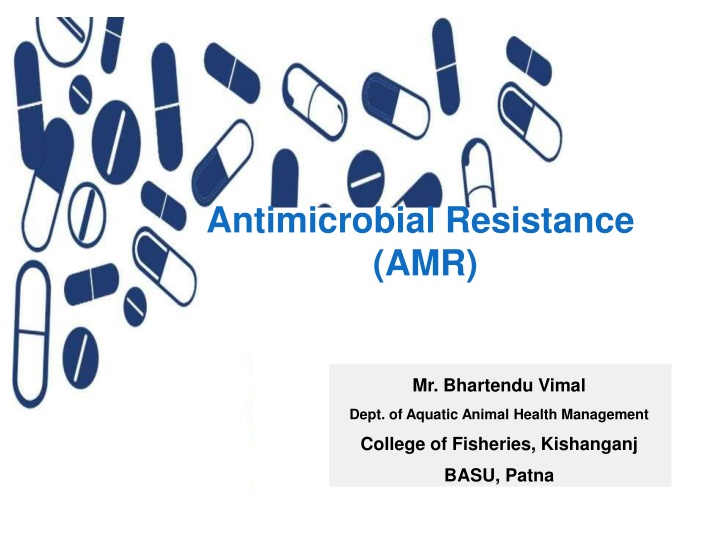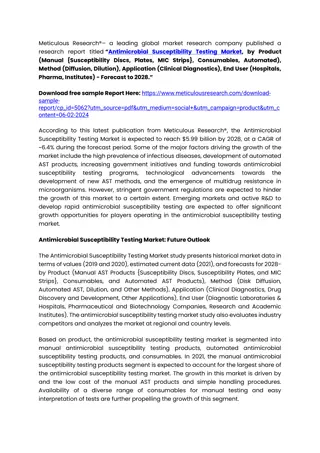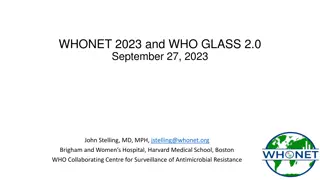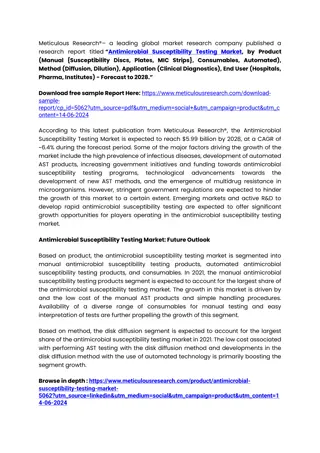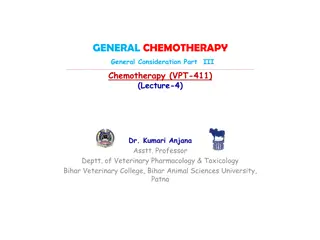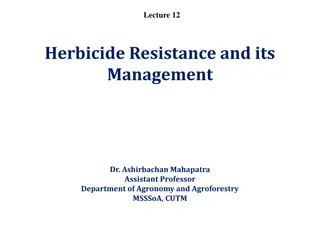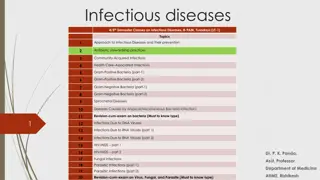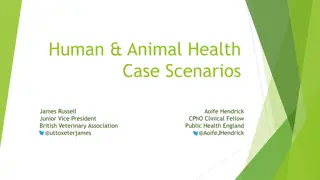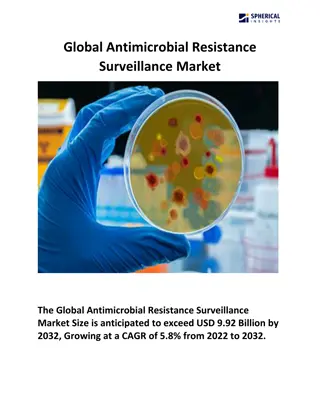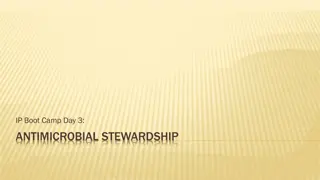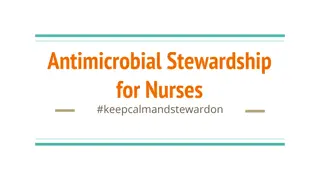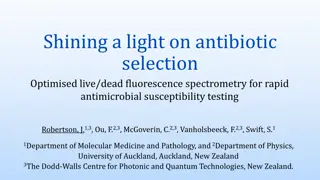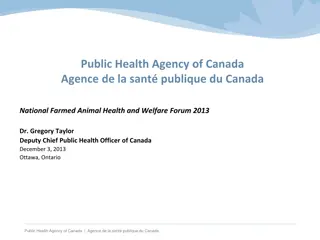Antimicrobial Resistance
Antimicrobial Resistance (AMR) poses a significant threat to public health, leading to increased morbidity and mortality worldwide. Pathogenic microorganisms can develop resistance to various antimicrobial agents, contributing to nearly 700,000 deaths annually. Factors such as environmental, drug-related, host-related, and prescriber-related elements play crucial roles in the proliferation of antibiotic resistance. Awareness of these factors is essential in combating this growing challenge.
Uploaded on Feb 24, 2025 | 4 Views
Download Presentation

Please find below an Image/Link to download the presentation.
The content on the website is provided AS IS for your information and personal use only. It may not be sold, licensed, or shared on other websites without obtaining consent from the author.If you encounter any issues during the download, it is possible that the publisher has removed the file from their server.
You are allowed to download the files provided on this website for personal or commercial use, subject to the condition that they are used lawfully. All files are the property of their respective owners.
The content on the website is provided AS IS for your information and personal use only. It may not be sold, licensed, or shared on other websites without obtaining consent from the author.
E N D
Presentation Transcript
Antimicrobial Resistance (AMR) Mr. Bhartendu Vimal Dept. of Aquatic Animal Health Management College of Fisheries, Kishanganj BASU, Patna
Antimicrobial Resistance Antimicrobial resistance (AMR) is one of the most serious public health threats of the twenty-first century . Resistance to antimicrobial agents has become a major source of morbidity and mortality worldwide. 2
Nearly 700,000 people around the world die every year due to drug- resistant infections. 3
Antimicrobial agents Antimicrobial agents can be divided into groups based on the mechanism of antimicrobial activity. 1. Agents that inhibit cell wall synthesis. 2. Depolarize the cell membrane. 3. Inhibit protein synthesis. 4. Inhibit nuclei acid synthesis. 5. Inhibit metabolic pathways in bacteria. 4
Antimicrobial Resistance Most pathogenic microorganisms have the capability of developing resistance to at least some antimicrobial agents. 5
Factors contributing to Antibiotic Resistance 1 Environmental Factors. 2 Drug Related Factors. 3 Host Related Factors. 4 Prescriber Related Factors. 6
1. Environmental Factors 1. Huge populations and overstocking 2. Rapid spread Raceways and RAS 3. Poor sanitation 4. Increases community acquired resistance 5. Ineffective infection control program 6. Increasing national and international unaunthicated seeds. 7. Widespread use of antibiotics in animal husbandry and agriculture and as medicated cleansing products. 7
2- Drug Related Factors 1. Fake drugs. 2. Quality of the drug. 3. Soaring use of antibiotics. 4. Over the counter availability of antimicrobials. 5. Irrational fixed dose combination of antimicrobials 6. Counterfeit and substandard drug causing sub-optimal blood concentration 8
3. Host Related Factors 1. Poor adherence of dosage Regimens 2. Lack of sanitation concept. 3. Lack of education. 4. Misconception. 9
4-Prescriber Related Factors 1. Inappropriate use of available drugs. 2. Increased empiric poly-antimicrobial use. 3. Overuse of antimicrobials. 4. Inadequate dosing. 5. Lack of current knowledge and training. 10
So also just remember , there is natural resistances of bacteria against antibiotics , so it is not fault on these four factors. 11
Bacteriostatic vs. Bacteriocidal Static antibiotics include: Chloramphenicol, Macrolides, Clindamycin, Sulfa, Trimethoprim, Tetracyclines Cidal antibiotics include: Aminoglycosides, Beta- lactams, Vancomycin, Quinolones, Rifampin, and Metronidazole. 13
ANTIMICROBIAL RESISTANCE Antimicrobial resistance can be of two types, intrinsic and acquired. 14
Intrinsic or natural (always expressed in the species), It is the innate ability of a bacterium to resist a class of antibiotics. The most common bacterial mechanisms involved in intrinsic resistance are reduced permeability of the outer membrane (LPS) and the natural activity of efflux pumps. 15
b) Acquired resistance whereby a naturally susceptible microorganism acquires ways of not being affected by the drug. Bacteria acquire any genetic material: transformation, transposition, and conjugation (all termed horizontal gene transfer-HGT), plus, the bacteria may experience mutations to its own chromosomal DNA. 16
Non-genetics 17
Mechanism of Antimicrobial Resistance Bacteria develop antimicrobial resistance by several mechanisms. 1. Limiting uptake of a drug. (natural) 2. Modification of a drug target. 3. Inactivation of a drug. 4. Active efflux of a drug. 18
Mechanism of Antimicrobial Resistance Because of differences in structure, there is variation in the types of mechanisms used by Gram negative bacteria versus Gram positive bacteria. Gram negative bacteria make use of all four main mechanisms, whereas Gram positive bacteria less commonly use limiting the uptake of a drug (don't have an LPS outer membrane), and don't have the capacity for certain types of drug efflux mechanisms. 19
1 3 2 4 20
1. Limiting uptake of adrug. There is a natural difference in the ability of bacteria to limit the uptake of antimicrobial agents. The structure and functions of the LPS layer in G- bacteria provides a barrier to certain types of molecules. 21
Certain bacteria modify their cell membrane porin channels; thereby preventing the antimicrobials from entering into the cell. (genetics) There are two main ways in which porin changes can limit drug uptake: a decrease in the number of porins present, and mutations that change the selectivity of the porin channel. 22
This strategy has been observed in many Gram- bacteria such as Pseudomonas, Enterobacter and Klebsiella species against drugs such as imipenem, aminoglycosides and quinolones. 23
Gram positive bacteria, Staphylococcus aureus, recently has developed resistance to vancomycin. Of the two mechanisms that S. aureus uses against vancomycin. S. aureus produce a thickened cell wall which makes it difficult for the drug to enter the cell and Provides an intermediate resistance to vancomycin. These strains are designated as VISA strains. (non-genetic) 24
2. Modification of a drug target. There are multiple components in the bacterial cell that may be targets of antimicrobial agents and there are just as many targets that may be modified by the bacteria to enable resistance to those drugs. (genetic) 25
One mechanism of resistance to the -lactam drugs used almost exclusively by G+ bacteria is via alterations in the structure and/or number of PBPs (penicillin-binding proteins). PBPs are transpeptidases involved in the construction of peptidoglycan in the cell wall. 26
A change in the number (increase in PBPs that have a decrease in drug binding ability, or decrease in PBPs with normal drug binding) of PBPs impacts the amount of drug that can bind to that target. 27
A change in structure (e.g. PBP2a in S. aureus by acquisition of the mecA gene) may decrease the ability of the drug to bind, or totally inhibit drug binding. 28
The glycopeptides (e.g. vancomycin) also work by inhibiting cell wall synthesis and lipopeptides (e.g. daptomycin) work by depolarizing the cell membrane. Resistance to vancomycin has become a major issue in the enterococci (VRE vancomycin-resistant enterococci) and in Staphylococcus aureus (MRSA- Methicillin-resistant Staphylococcus aureus). 29
Resistance is mediated through acquisition of van genes which results in changes in the structure of peptidoglycan precursors that cause a decrease in the binding ability of vancomycin. Daptomycin requires the presence of calcium for binding. Mutations in genes (e.g. mprF) change the charge of the cell membrane surface to positive, inhibiting the binding of calcium, and therefore, daptomycin. 30
Resistance to drugs that target the ribosomal subunits may occur via ribosomal mutation (aminoglycosides) ,ribosomal subunit methylation most commonly involving erm genes, or ribosomal protection (tetracyclines). These mechanisms interfere with the ability of the drug to bind to the ribosome. 31
Selective toxicity (antibiotics) , the only affect the bacterium not human, due to affect the specific genes that only bacteria. 32
For drugs that target nucleic acid synthesis (fluoroquinolones), resistance is via modifications in DNA gyrase (G- bacteria e.g. gyrA) or topoisomerase IV (G + bacteria e.g. grlA). These mutations cause changes in the structure of gyrase and topoisomerase which decrease or eliminate the ability of the drug to bind to these components. 33
3. Inactivation of a drug. There are two main ways in which bacteria inactivate drugs; by 1 Actual degradation of the drug, or by 2 Transfer of a chemical group to the drug. 34
1-Actual degradation of the drug, or by The -lactamases are a very large group of drug hydrolyzing enzymes .Another drug that can be inactivated by hydrolyzation is tetracycline, via the tetX gene. 35
2-Transfer of a chemical group to the drug. Drug inactivation by transfer of a chemical group to the drug most commonly uses transfer of acetyl group. There are a large number of transferases that have been identified. Acetylation is the most diversely used mechanism, and is known to be used against the aminoglycosides. 36
4. Active efflux of a drug. Bacteria possess chromosomally encoded genes for efflux pumps. Some are expressed constitutively, and others are induced or overexpressed (high-level resistance is usually via a mutation that modifies the transport channel) under certain environmental stimuli or when a suitable substrate is present. The efflux pumps function primarily to rid the bacterial cell of toxic substances, and many of these pumps will transport a large variety of compounds (multi-drug [MDR] efflux pumps). 37
Most bacteria possess many different types of efflux pumps. There are five main families of efflux pumps in bacteria classified based on structure and energy source: 1 The ATP-binding cassette (ABC) family, 2The multidrug and toxic compound extrusion (MATE) family, 3-The small multidrug resistance (SMR) family, 4 The major facilitator superfamily (MFS), and 5 The resistance-nodulation-cell division (RND) family. 38
Efflux pumps found in G + bacteria may confer intrinsic resistance because of being encoded on the chromosome (natural). There are also G + efflux pumps known to be carried on plasmids (aquarid). These pumps include members of the MATE and MFS families. Efflux pumps found in G -bacteria are widely distributed and may come from all five of the families, with the most clinically significant pumps belonging to the RND family. 39
What is the difference between antibiotic and antimicrobial resistance? Antibiotics are medicines used to prevent and treat bacterial infections. Antibiotic resistance occurs when bacteria change in response to the use of these medicines. Bacteria, not humans, become antibiotic resistant. These bacteria may then infect humans and are harder to treat than non-resistant bacteria. Antimicrobial resistance is a broader term, encompassing resistance to drugs to treat infections caused by other microbes as well, such as parasites (e.g. malaria), viruses (e.g. HIV) and fungi (e.g. Candida). 41
Summary 43
References An overview of the antimicrobial resistance mechanisms of bacteria ,2018, doi: 10.3934/microbiol.2018.3.482. A Review on Antibiotic Resistance: Alarm Bells are Ringing,2017, doi: 10.7759/cureus.1403 WHO,2018 CDC,2018 44
